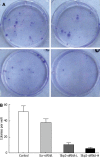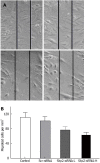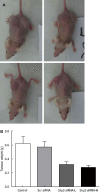Skp2-RNAi suppresses proliferation and migration of gallbladder carcinoma cells by enhancing p27 expression
- PMID: 23946596
- PMCID: PMC3740421
- DOI: 10.3748/wjg.v19.i30.4917
Skp2-RNAi suppresses proliferation and migration of gallbladder carcinoma cells by enhancing p27 expression
Abstract
Aim: To explore the role of S-phase kinase-associated protein-2 (Skp2) in gallbladder carcinoma and to identify whether depletion of Skp2 by Skp2-RNAi could attenuate proliferation and migration of gallbladder carcinoma.
Methods: Skp2-RNAi was transduced into cells of the gallbladder carcinoma cell line GBC-SD, using a lentiviral vector. The effect of Skp2-RNAi on the proliferation, migration, invasion and cell cycle of GBC-SD cells was studied using in vitro assays for cell proliferation, colony formation, wound healing and cell cycle. The expression of Skp2 and p27 was detected by real-time polymerase chain reaction and Western immunoblotting. The effect of Skp2-RNAi on the proliferation of GBC-SD cells in vivo was investigated by tumorigenicity experiments in nude mice.
Results: Lentivirus-mediated RNAi reduced the expression of Skp2 in cultured cells. The expression of the p27 protein increased along with the down-regulation of Skp2, although no significant difference was found in p27 mRNA expression. Flow cytometry revealed that Skp2-RNAi transfection significantly increased the proportion of cells in the S phase and significantly decreased the proportion of cells in the G2/M phase. No significant difference in the frequency of cells in the G0/G1 phase was observed. The results from the cell proliferation, colony formation and wound healing assays revealed that Skp2-RNAi transfection markedly inhibited the proliferation and migration of GBC-SD cells in vitro. Additionally, tumorigenicity experiments showed that suppression of Skp2 significantly decreased the weights of the tumors (0.56 ± 0.11 and 0.55 ± 0.07 g in the control and Scr-RNAi groups vs 0.37 ± 0.09 and 0.35 ± 0.08 g in the Skp2-RNAi-L and Skp2-RNAi-H groups).
Conclusion: The expression of Skp2 in GBC-SD cells was inhibited following Skp2-RNAi transfection. Silencing of the Skp2 gene inhibited proliferation, migration and invasiveness of GBC-SD cells by mechanisms dependent on enhanced expression of the p27 protein.
Keywords: Cell cycle; Gallbladder carcinoma; Gene therapy; S-phase kinase-associated protein-2; p27.
Figures






References
-
- Clemente G, Nuzzo G, De Rose AM, Giovannini I, La Torre G, Ardito F, Giuliante F. Unexpected gallbladder cancer after laparoscopic cholecystectomy for acute cholecystitis: a worrisome picture. J Gastrointest Surg. 2012;16:1462–1468. - PubMed
-
- Groth A, Willumsen BM. High-density growth arrest in Ras-transformed cells: low Cdk kinase activities in spite of absence of p27(Kip) Cdk-complexes. Cell Signal. 2005;17:1063–1073. - PubMed
MeSH terms
Substances
LinkOut - more resources
Full Text Sources
Other Literature Sources
Medical
Miscellaneous

